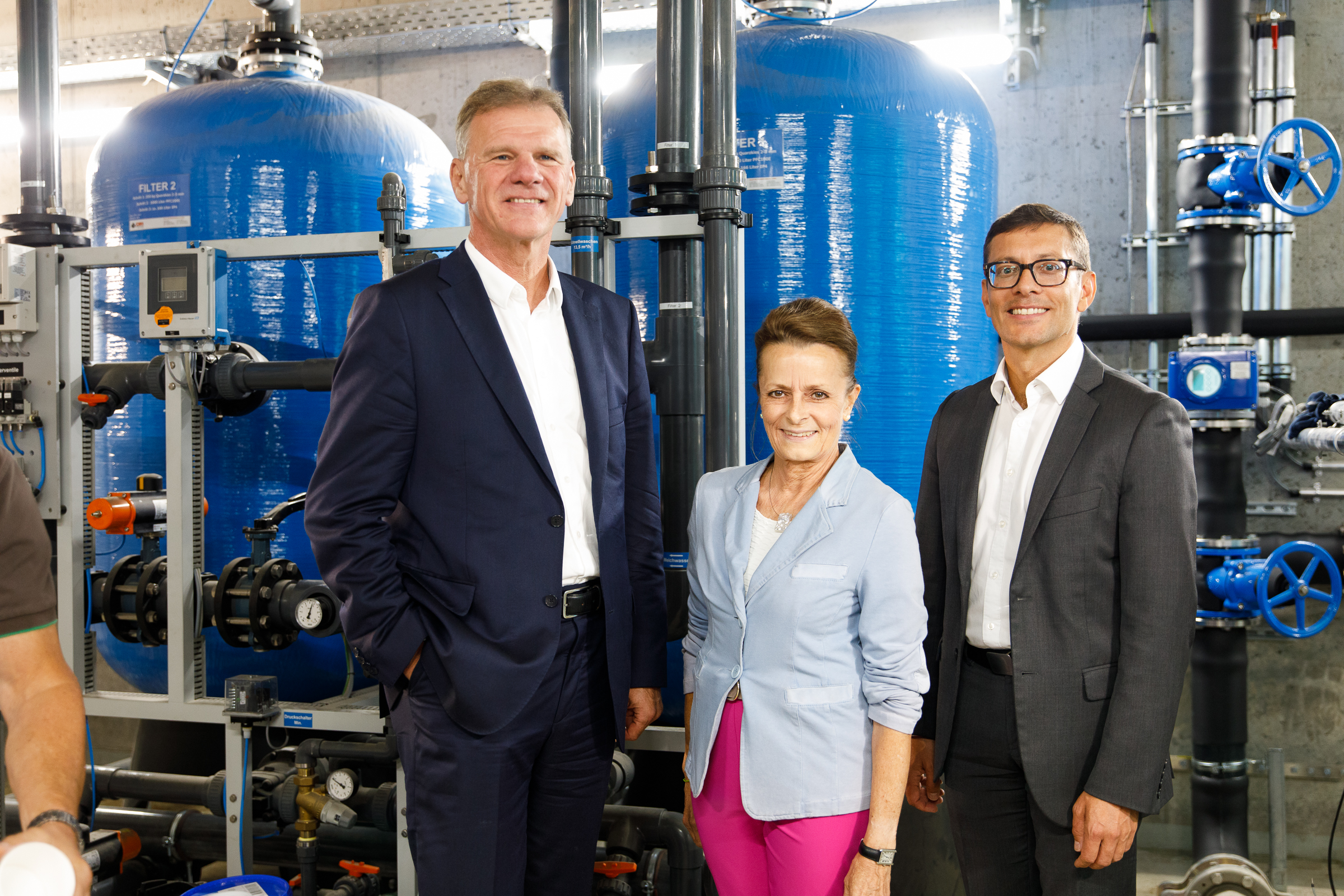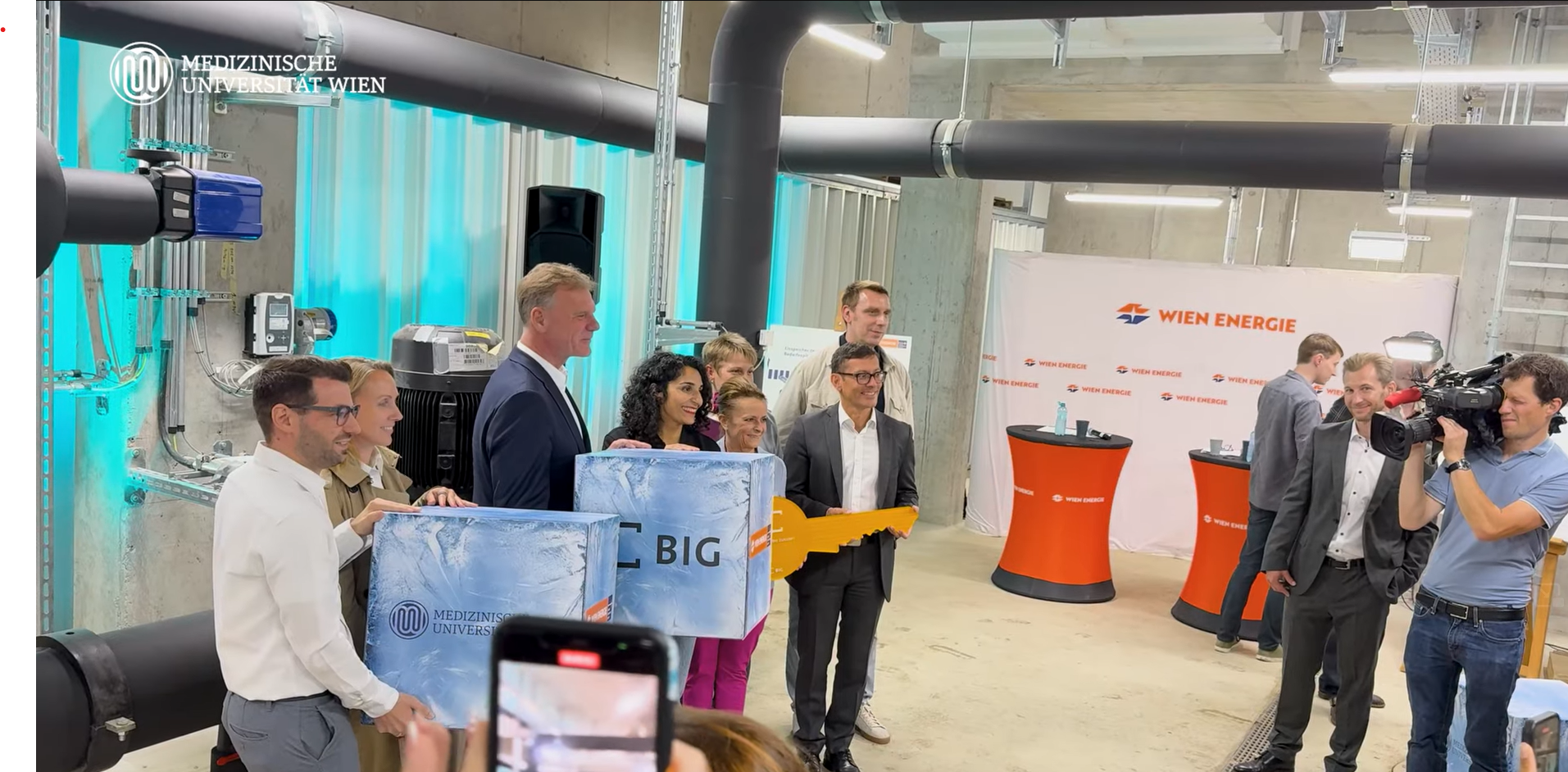
(Vienna, 28 July 2025) – Wien Energie has commissioned its eighth large district cooling plant on the MedUni Mariannengasse campus. The building complex in Vienna's Alsergrund district is being constructed by the Federal Real Estate Company (BIG). A technical highlight: for the first time, an innovative ice storage system is being used at this location, which, together with the use of waste heat, ensures particularly resource-efficient cooling.
"The district cooling centre at the MedUni Mariannengasse campus is an important milestone in the expansion of Vienna's district cooling network," says Michael Strebl, CEO of Wien Energie. "From here, we will connect the district cooling network around Vienna's city centre with the AKH and the Spittelau district cooling centre. Summers are getting hotter and the demand for climate-friendly cooling is growing. That is why we have been continuously expanding district cooling since 2007. We will invest a total of 90 million euros here by 2030."
It is the eighth large cooling plant in the Wien Energie network. The largest customer will be the new MedUni Campus Mariannengasse, which is currently under construction on the site. "With the new MedUni Campus Mariannengasse, we are continuing Vienna's important tradition as the world capital of medicine. In the heart of the ninth district, we are ensuring the highest level of medical research and teaching and thus the training of future doctors. The campus is setting new standards not only in terms of architecture and construction, but also in terms of energy efficiency. The district cooling centre is an important aspect of this, and BIG is enabling its construction as part of the campus development. It will supply cooling to the university campus and several buildings in the neighbourhood, and will also heat the MedUni Campus using waste heat," says Christine Dornaus, Managing Director of the Bundesimmobiliengesellschaft BIG (Federal Real Estate Company).
Compared to conventional air conditioning systems, the district cooling centre at the MedUni Campus Mariannengasse saves 1,000 tonnes of CO2 emissions annually. This corresponds to the CO2 binding capacity of 80,000 trees. A heat pump also utilises the waste heat from the cooling production. This is because cooling is needed all year round, even in winter. In summer, the waste heat from cooling can cover the entire heating requirements of the building.
"MedUni Vienna is one of the most renowned universities in medical research, university medical care and research-led training for future doctors. By connecting and supplying the MedUni Campus Mariannengasse via the newly built district cooling centre, we are taking an active step in our social responsibility and setting an example in the areas of sustainability, resource conservation and limiting the climate crisis ," explains Volkan Talazoglu, Vice Rector for Finance at MedUni Vienna. "Wien Energie's sustainable supply lines also reflect the strong roots of the open-plan MedUni Campus Mariannengasse in the entire district."

Ice storage system commissioned for the first time
A technical innovation in Vienna's district cooling network is that Wien Energie is putting an ice storage facility into operation for the first time at the MedUni Campus Mariannengasse. Put simply, this is a ten-metre-long, insulated container filled with water. This water can be frozen into a giant ice cube via hoses filled with coolant. To "unload" the storage tank, the ice is melted, releasing the cold energy, which is then transferred to the district cooling network via the coolant hoses and heat exchangers.
The ice storage system is designed to cover peak consumption and thus enable more efficient operation of the cooling centre. Although cooling is required around the clock, consumption rises sharply between 11 a.m. and 4 p.m. in summer. The ice storage system allows the chillers to be used more evenly and thus more efficiently: when consumption is lower, for example at night, the ice storage system is charged so that it can release the cold when it is needed.
When fully completed, the site will have three electric chillers powered by green electricity, a heat pump and an absorption chiller powered by district heating.
About the Vienna district cooling network
District cooling is generated in separate central units with highly efficient chillers in the form of cold water from waste heat or green electricity. The water, cooled to around 5-6 degrees Celsius, is transported to customers via insulated pipes and distributed throughout the buildings via the in-house cooling systems. The water absorbs heat from the building and transports it away. Recooling is also carried out centrally, using river water where possible.
Compared to conventional air conditioning systems, district cooling reduces CO2 emissions by 50 per cent. Another advantage is that the waste heat is not released into the immediate environment via fans. Unlike split air conditioning units, district cooling therefore does not contribute to the formation of heat islands in the city.
Customers include numerous public buildings such as the Vienna General Hospital, the City Hall and the University of Vienna, numerous office and commercial locations, cultural institutions such as the Ronacher Musical Theatre and the Natural History Museum, as well as hotels and restaurants such as the Hotel Sacher.
About the MedUni Campus Mariannengasse
The MedUni Campus Mariannengasse offers space for 2,000 students and 750 employees. In addition to lecture halls, practice rooms and learning areas, the building offers the best possible conditions for medical research and teaching on a total of 35,000 square metres of floor space. The listed existing building is being renovated and serves as a link between the old and new buildings. In addition to district cooling, the energy concept includes low-temperature heating, a district heating connection and highly efficient heat recovery from the central ventilation systems, including laboratory ventilation. The university will begin operations in the 2027/2028 winter semester. By then, the district cooling centre will already be feeding into the cooling network.

After activation, data will be sent to YouTube. Further information here: Data protection
Facts and figures
Capacity of the district cooling centre at the MedUni Campus Mariannengasse when fully completed: 17.7 megawatts
Ice storage capacity: 6 megawatt hours
External dimensions of ice storage: 10x4x3 metres (LBH)
Total investment in the MedUni Campus Mariannengasse district cooling centre: 22 million euros
Vienna district cooling network: 30 kilometres
Cooling centres: 8 with grid connection, 17 local cooling centres without grid connection
Buildings supplied: 220
Vienna district cooling capacity in 2025: 240 megawatts
Vienna district cooling capacity in 2030: 370 megawatts